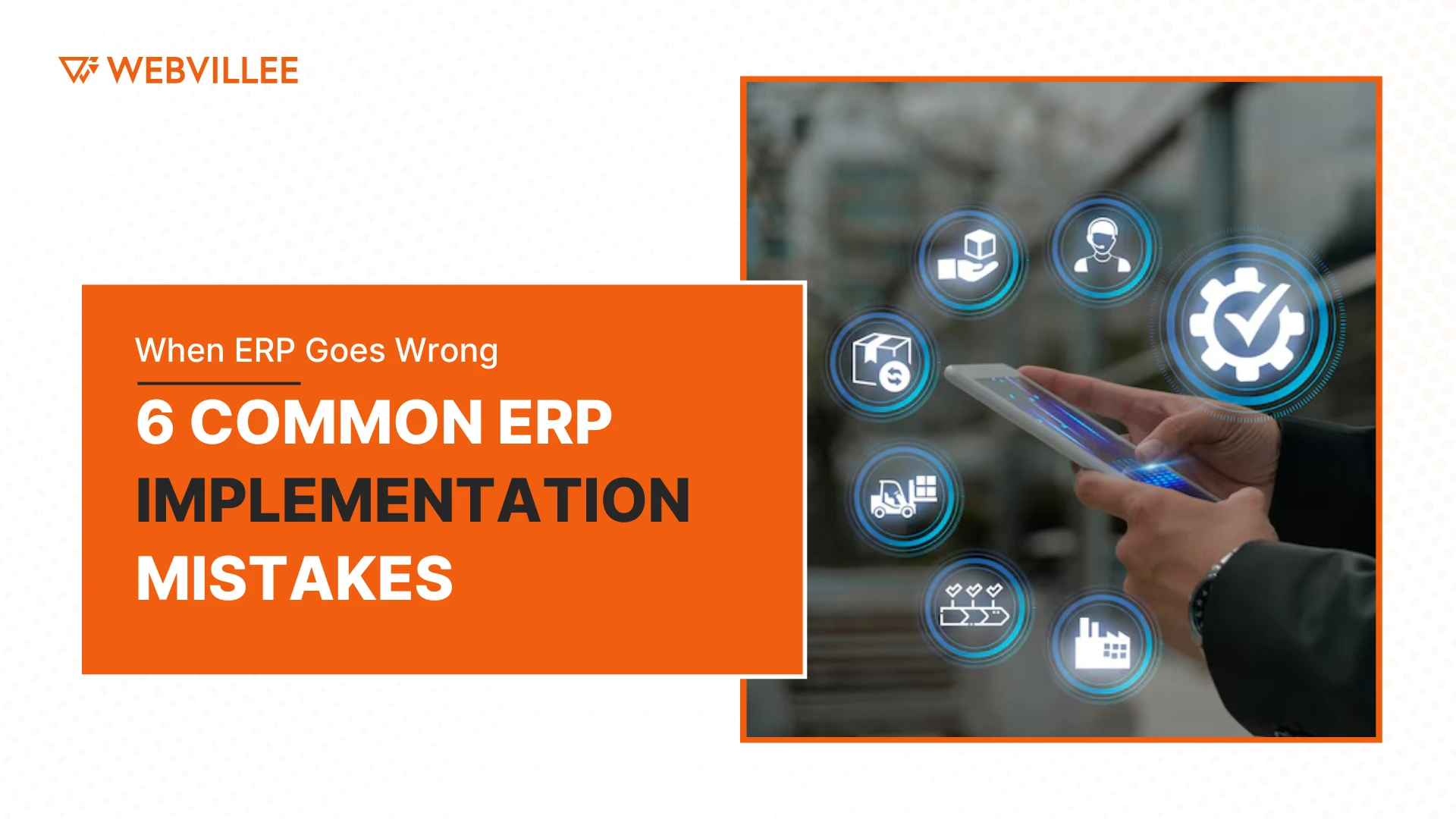ERP implementation mistakes are more common than you might think, and far more expensive than most businesses expect. Whether you are switching systems or adopting one for the first time, the decisions you make early on will impact operations, budgets, and growth.
ERP is not just a tool. It touches nearly every part of your business, from finance and HR to inventory and customer support. A smooth rollout can improve productivity and data visibility. But a flawed setup can disrupt daily work, confuse teams, and lead to long-term setbacks.
The stakes are high:
- Budget overruns
- Delays in delivery
- Data migration issues
- Poor user adoption
- Inefficient processes
- Missed reporting accuracy
In this blog, we’ll explore six common ERP implementation mistakes and how to avoid them.
If you’re also considering a broader digital strategy, Webvillee offers end-to-end CRM and ERP service to ensure everything runs together seamlessly.
Mistake 1: Skipping the Planning Phase
One of the biggest ERP implementation mistakes is jumping in without a solid plan. It might feel faster to start development or data migration immediately, but skipping planning leads to confusion, delays, and rework down the line.
Poor planning usually looks like this:
- Vague or shifting goals
- Unclear project scope or priorities
- Missing or unrealistic timelines
- No defined roles or ownership
- Lack of coordination across departments
Without a roadmap, even the best ERP tools can fail. Every decision becomes reactive rather than strategic, and the risk of misalignment increases with every new step.
Here’s how to avoid it:
- Start with clear, measurable goals for the ERP project
- Gather detailed requirements from every department involved
- Build a phased roadmap with timelines, dependencies, and responsibilities
- Identify all stakeholders early and define their roles
- Plan for training, testing, and user feedback before launch
A little extra time in the planning phase will save you a lot of time and money later.

Mistake 2: Choosing the Wrong ERP System
Not every ERP system fits every business. One of the most common ERP implementation mistakes is selecting a platform based on popularity, vendor hype, or just cost savings.
When the system does not match your actual business needs, problems pile up quickly:
- Workflow misalignment
- Unnecessary complexity or missing features
- Poor integration with existing tools
- Frustrated users and slow adoption
To avoid this mistake, step back and do a full fit-gap analysis. Start with a clear understanding of your daily processes, pain points, and goals.
Here’s what helps:
- Build a business case based on actual problems and expected outcomes
- Map use cases across departments, such as finance, HR, operations, and inventory
- Check if the system is modular and scalable to grow with your business
- Review customer support, update cycles, and vendor reputation
A good ERP system should feel like an extension of your team. It should support your growth, not create new roadblocks.
Mistake 3: Underestimating Data Migration Challenges
Many teams assume that moving data from old systems into a new ERP is just a technical step. In reality, it is one of the most complex parts of any implementation.
Data issues can cause serious problems:
- Lost or corrupted records
- Duplicated entries that confuse reporting
- Incompatibility with new data structures
These problems don’t just slow things down. They also create mistrust in the new system from day one.
To avoid this mistake, build a clear plan for data migration from the start:
- Audit your current data – Clean up outdated, duplicate, or incomplete records before migration
- Validate mappings – Ensure each field in the old system has a clear destination in the new ERP
- Run test migrations – Start with a pilot transfer to catch issues early before full-scale rollout
- Create a fallback plan – Always have a backup and rollback strategy in case something goes wrong
Treat your data with care. Clean, consistent, and accurate data is the foundation of ERP success. Skipping this step puts your entire system at risk.

Mistake 4: Not Involving Key Stakeholders Early
ERP implementation is not just an IT responsibility. It affects how every team operates, from finance and HR to sales and logistics.
Leaving key stakeholders out of early conversations leads to:
- Misaligned goals
- Low adoption after go-live
- Resistance from teams who feel left out of the process
Without early buy-in, the ERP may be seen as a top-down change rather than a tool for collective improvement.
To avoid this mistake:
- Identify all affected departments early – Make sure every major function has a voice in the planning phase
- Create feedback loops – Involve department heads and team leads when gathering requirements and testing features
- Assign internal champions – Empower trusted employees to represent their teams, share updates, and drive adoption
When people feel heard and involved, they are more likely to support the transition. Early engagement builds trust and reduces friction when it’s time to go live.
Mistake 5: Lack of Employee Training and Change Management
Even the most powerful ERP system will fail if your team does not know how to use it effectively.
Without proper training, employees may:
- Struggle with new workflows
- Revert to outdated methods
- Make costly data entry errors
Resistance often stems from confusion, not refusal. When teams are left to figure it out on their own, frustration builds quickly.
Here’s how to avoid this mistake:
- Provide structured training – Offer role-specific sessions that explain new tasks, tools, and processes
- Set up ongoing support – Create a helpdesk or internal support team for post-go-live questions and troubleshooting
- Roll out the ERP in phases – Start with one department or function to identify gaps before expanding company-wide
A well-trained team feels more confident, efficient, and ready to embrace change. When people understand how the system helps them, they are more likely to support it and use it consistently.

Mistake 6: Ignoring Post-Go-Live Support and Optimization
Many businesses think the ERP journey ends at launch. In reality, that’s when the real work begins.
Without proper post-go-live support, you may face:
- Slow system performance
- Gaps in business processes
- User frustration and lower productivity
The early weeks after deployment are critical for user adoption and system stability. If no one is tracking usage or resolving issues, small problems can escalate quickly.
To avoid this mistake:
- Set up a monitoring plan – Track system load, transaction speed, and user behavior from day one
- Create a feedback loop – Encourage users to report bugs or improvement areas and act on them regularly
- Plan for continuous optimization – Schedule quarterly reviews to refine workflows, apply updates, and improve efficiency
ERP systems evolve with your business. Ongoing support ensures your investment continues to deliver value as your operations grow and change. Ignoring this phase often leads to missed opportunities and added costs later on.
Webvillee’s Approach to Successful ERP Implementation
At Webvillee, we know ERP implementation is more than just installing software. It is a shift in how your business operates and grows. That is why our approach focuses on the full journey, from planning to post-launch optimization.
We work closely with your team to:
- Define clear goals and timelines
- Select and customize ERP systems that fit your business
- Ensure accurate data migration with validation steps
- Train your staff to build comfort and confidence
- Provide continuous support and refinement after go-live
Our team brings experience across industries and understands the common ERP challenges that cause delays, budget issues, or poor user adoption. We guide you with clear roadmaps, real-time communication, and hands-on problem solving.
Whether you are starting your first ERP project or optimizing an existing system, Webvillee helps you build with fewer surprises and better results.
Contact us to start planning your ERP implementation with confidence. Let’s get it right from the beginning.

